Please note, this post was updated in 2020 and I no longer update this website.
How often does this scenario play out in your classroom?
You want your students to go online and do some research for some sort of project, essay, story or presentation. Time ticks away, students are busy searching and clicking, but are they finding the useful and accurate information they need for their project?
We’re very fortunate that many classrooms are now well equipped with devices and the internet, so accessing the wealth of information online should be easier than ever, however, there are many obstacles.
Students (and teachers) need to navigate:
- What search terms to put into Google or other search engines
- What search results to click on and read through (while avoiding inappropriate or irrelevant sites or advertisements)
- How to determine what information is credible, relevant and student friendly
- How to process, synthesize, evaluate, and present the information
- How to compare a range of sources to evaluate their reliability and relevancy
- How to cite sources correctly
Phew! No wonder things often don’t turn out as expected when you tell your students to just “google” their topic. On top of these difficulties some students face other obstacles including: low literacy skills, limited internet access, language barriers, learning difficulties and disabilities.
All of the skills involved in online research can be said to come under the term of information literacy, which tends to fall under a broader umbrella term of digital literacy.
Being literate in this way is an essential life skill.
This post offers tips and suggestions on how to approach this big topic. You’ll learn a 5 step method to break down the research process into manageable chunks in the classroom.
Scroll down to find a handy poster for your classroom too.
How to Teach Information Literacy and Online Research Skills
The topic of researching and filtering information can be broken down in so many ways but I believe the best approach involves:
- Starting young and building on skills
- Embedding explicit teaching and mini-lessons regularly (check out my 50 mini-lesson ideas here!)
- Providing lots of opportunity for practice and feedback
- Teachers seeking to improve their own skills — these free courses from Google might help
- Working with your librarian if you have one
💡 While teaching research skills is something that should be worked on throughout the year, I also like the idea of starting the year off strongly with a “Research Day” which is something 7th grade teacher Dan Gallagher wrote about. Dan and his colleagues had their students spend a day rotating around different activities to learn more about researching online. Something to think about!
Google or a Kid-friendly Search Engine?
If you teach young students you might be wondering what the best starting place is.
I’ve only ever used Google with students but I know many teachers like to start with search engines designed for children. If you’ve tried these search engines, I’d love you to add your thoughts in a comment.
💡 If you’re not using a kid-friendly search engine, definitely make sure SafeSearch is activated on Google or Bing. It’s not foolproof but it helps.
Two search engines designed for children that look particularly useful include:
These sites are powered by Google SafeSearch with some extra filtering/moderating.
KidzSearch contains additional features like videos and image sections to browse. While not necessarily a bad thing, I prefer the simple interface of Kiddle for beginners.
Read more about child-friendly search engines
This article from Naked Security provides a helpful overview of using child-friendly search engines like Kiddle.
To summarise their findings, search-engines like Kiddle can be useful but are not perfect.
For younger children who need to be online but are far too young to be left to their own devices, and for parents and educators that want little ones to easily avoid age-inappropriate content, these search engines are quite a handy tool.
For older children, however, the results in these search engines may be too restrictive to be useful, and will likely only frustrate children to use other means.
Remember, these sorts of tools are not a replacement for education and supervision.
Maybe start with no search engine?
Another possible starting point for researching with young students is avoiding a search engine altogether.
Students could head straight to a site they’ve used before (or choose from a small number of teacher suggested sites). There’s a lot to be learned just from finding, filtering, and using information found on various websites.
Five Steps to Teaching Students How to Research Online and Filter Information
This five-step model might be a useful starting point for your students to consider every time they embark on some research.
Let’s break down each step. You can find a summary poster at the end.
1) Clarify
Students first need to take a moment to consider what information they’re actually looking for in their searches.
It can be a worthwhile exercise to add this extra step in between giving a student a task (or choice of tasks) and sending them off to research.
You could have a class discussion or small group conferences on brainstorming keywords, considering synonyms or alternative phrases, generating questions etc. Mindmapping might help too.
2016 research by Morrison showed that 80% of students rarely or never made a list of possible search words. This may be a fairly easy habit to start with.
Time spent defining the task can lead to a more effective and streamlined research process.
2) Search
It sounds simple but students need to know that the quality of the search terms they put in the Google search box will determine the quality of their results.
There are a LOT of tips and tricks for Googling but I think it’s best to have students first master the basics of doing a proper Google search.
I recommend consolidating these basics:
- Type in some simple search terms using only the important keywords
- If the initial results aren’t what you want, alter the search terms and get more specific (get clues from the initial search results e.g. you might see synonyms that would work or get ideas from the “People Also Ask” section)
- Use quotation marks if you want your keywords in an exact order, e.g. “raining cats and dogs”
- Remember:
- use your best guess with spelling (Google will often understand)
- don’t worry about punctuation
- understand that everyone’s results will be different, even if they use the same search terms (depending on browser history, location etc.)
📌 Get a free PDF of this poster here.
Links to learn more about Google searches
There’s lots you can learn about Google searches.
I highly recommend you take a look at 20 Instant Google Searches your Students Need to Know by Eric Curts to learn about “instant searches”.
Med Kharbach has also shared a simple visual with 12 search tips which would be really handy once students master the basics too.
The Google Search Education website is an amazing resource with lessons for beginner/intermediate/advanced plus slideshows and videos. It’s also home to the A Google A Day classroom challenges. The questions help older students learn about choosing keywords, deconstructing questions, and altering keywords.
Useful videos about Google searches
How Search Works
This easy to understand video from Code.org to explains more about how search works.
How Does Google Know Everything About Me?
You might like to share this video with older students that explains how Google knows what you’re typing or thinking. Despite this algorithm, Google can’t necessarily know what you’re looking for if you’re not clear with your search terms.
What about when the answer comes up in Google instantly?
If you’ve been using Google for a while, you know they are tweaking the search formula so that more and more, an answer will show up within the Google search result itself. You won’t even need to click through to any websites.
For example, here I’ve asked when the Titanic sunk. I don’t need to go to any websites to find out. The answer is right there in front of me.
While instant searches and featured snippets are great and mean you can “get an answer” without leaving Google, students often don’t have the background knowledge to know if a result is incorrect or not. So double checking is always a good idea.
As students get older, they’ll be able to know when they can trust an answer and when double checking is needed.
Type in a subject like cats and you’ll be presented with information about the animals, sports teams, the musical along with a lot of advertising. There are a lot of topics where some background knowledge helps. And that can only be developed with time and age.
3) Delve
Entering quality search terms is one thing but knowing what to click on is another.
You might like to encourage students to look beyond the first few results. Let students know that Google’s PageRank algorithm is complex (as per the video above), and many websites use Search Engine Optimisation to improve the visibility of their pages in search results. That doesn’t necessarily mean they’re the most useful or relevant sites for you.
As pointed out in this article by Scientific American,
Skilled searchers know that the ranking of results from a search engine is not a statement about objective truth, but about the best matching of the search query, term frequency, and the connectedness of web pages. Whether or not those results answer the searchers’ questions is still up for them to determine.
Point out the anatomy of a Google search result and ensure students know what all the components mean. This could be as part of a whole class discussion, or students could create their own annotations.
An important habit to get into is looking at the green URL and specifically the domain. Use some intuition to decide whether it seems reliable. Does the URL look like a well-known site? Is it a forum or opinion site? Is it an educational or government institution? Domains that include .gov or .edu might be more reliable sources.
When looking through possible results, you may want to teach students to open sites in new tabs, leaving their search results in a tab for easy access later (e.g. right-click on the title and click “Open link in new tab” or press Control/Command and click the link).
Searchers are often not skilled at identifying advertising within search results. A famous 2016 Stanford University study revealed that 82% of middle-schoolers couldn’t distinguish between an ad labelled “sponsored content” and a real news story.
Time spent identifying advertising within search results could help students become much more savvy searchers. Looking for the words “ad” and “sponsored” is a great place to start.
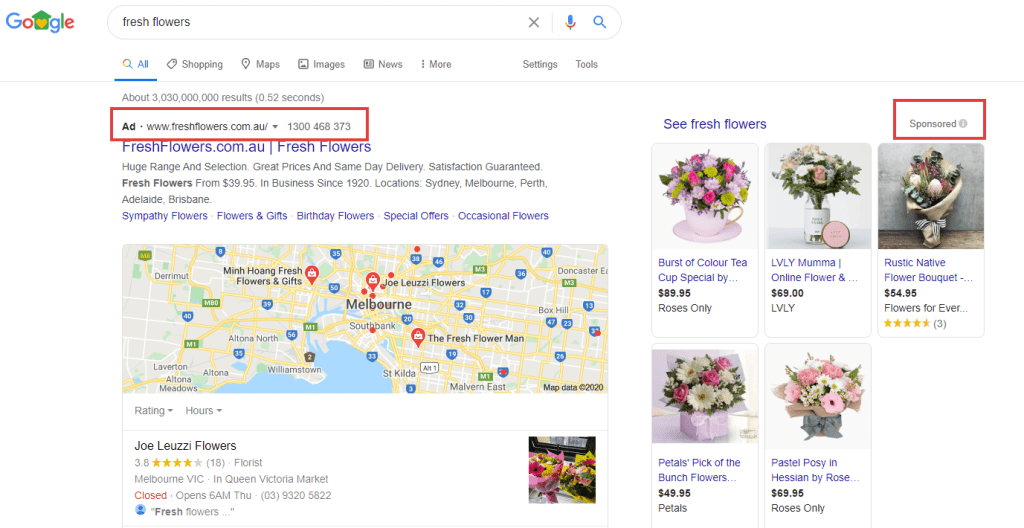
4) Evaluate
Once you click on a link and land on a site, how do you know if it offers the information you need?
Students need to know how to search for the specific information they’re after on a website. Teach students how to look for the search box on a webpage or use Control F (Command F on Mac) to bring up a search box that can scan the page.
Ensure students understand that you cannot believe everything you read. This might involve checking multiple sources. You might set up class guidelines that ask students to cross check their information on two or three different sites before assuming it’s accurate.
I’ve written a post all about teaching students how to evaluate websites. It includes this flowchart which you’re welcome to download and use in your classroom.
5) Cite
So your students navigated the obstacles of searching and finding information on quality websites. They’ve found what they need! Hooray.
Now what?
Many students will instinctively want to copy and paste the information they find for their own work.
We need to inform students about plagiarism and copyright infringement while giving them the skills they need to avoid this.
- Students need to know that plagiarism is taking someone’s work and presenting it as your own. You could have a class discussion about the ethics and legalities of this.
- Students also need to be assured that they can use information from other sources and they should. They just need to say who wrote it, where it was from and so on.
All students can benefit from learning about plagiarism, copyright, how to write information in their own words, and how to acknowledge the source. However, the formality of this process will depend on your students’ age and your curriculum guidelines.
Give students lots of practice writing information in their own words. Younger students can benefit from simply putting stories or recounts in their own words. Older students could investigate the difference between paraphrasing and summarising.
There are some free online tools that summarise information for you. These aren’t perfect and aren’t a replacement from learning the skill but they could be handy for students to try out and evaluate. For example, students could try writing their own summary and then comparing it to a computer summary. I like the tool SMMRY as you can enter text or a URL of an article. Eric Curts shares a list of 7 summary tools in this blog post.
Students also need a lot of practice using quotation marks and citing sources.
The internet can offer a confusing web of information at times. Students need to be shown how to look for the primary source of information. For example, if they find information on Wikipedia, they need to cite from the bibliography at the bottom of the Wikipedia article, not Wikipedia itself.
There are many ways you can teach citation:
- I like Kathy Schrock’s PDF document which demonstrates how you can progressively teach citation from grades 1 to 6 (and beyond). It gives some clear examples that you could adapt for your own classroom use.
Staying organised!
You might also like to set up a system for students to organise their information while they’re searching. There are many apps and online tools to curate, annotate, and bookmark information, however, you could just set up a simple system like a Google Doc or Spreadsheet.
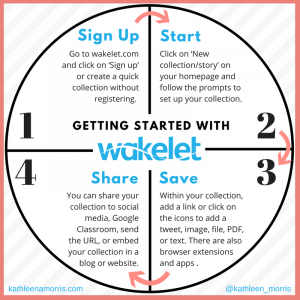 One free tool I’ve found particularly useful is Wakelet. Using Wakelet, you build collections of content from around the web.
One free tool I’ve found particularly useful is Wakelet. Using Wakelet, you build collections of content from around the web.
The format and function is simple and clear. This means students don’t have to put much thought into using and designing their collections. Instead, they can focus on the important curation process.
Bring These Ideas to Life With Mini-Lessons!
We know how important it is for students to have solid research skills. But how can you fit teaching research skills into a jam-packed curriculum? The answer may be … mini-lessons!
Whether you teach primary or secondary students, I’ve compiled 50 ideas for mini-lessons.
Try one a day or one a week and by the end of the school year, you might just be amazed at how independent your students are becoming with researching.
Become an Internet Search Master with This Google Slides Presentation
In early 2019, I was contacted by Noah King who is a teacher in Northern California.
Noah was teaching his students about my 5 step process outlined in this post and put together a Google Slides Presentation with elaboration and examples.
You’re welcome to use and adapt the Google Slides Presentation yourself. Find out exactly how to do this in this post.
The Presentation was designed for students around 10-11 years old but I think it could easily be adapted for different age groups.
Recap: How To Do Online Research
Despite many students being confident users of technology, they need to be taught how to find information online that’s relevant, factual, student-friendly, and safe.
Keep these six steps in mind whenever you need to do some online research:
- Clarify: What information are you looking for? Consider keywords, questions, synonyms, alternative phrases etc.
- Search: What are the best words you can type into the search engine to get the highest quality results?
- Delve: What search results should you click on and explore further?
- Evaluate: Once you click on a link and land on a site, how do you know if it offers the information you need?
- Cite: How can you write information in your own words (paraphrase or summarise), use direct quotes, and cite sources?
- Staying organised: How can you keep the valuable information you find online organised as you go through the research process?
Don’t forget to ask for help!
Lastly, remember to get help when you need it. If you’re lucky enough to have a teacher-librarian at your school, use them! They’re a wonderful resource.
If not, consult with other staff members, librarians at your local library, or members of your professional learning network. There are lots of people out there who are willing and able to help with research. You just need to ask!
Conclusion
Being able to research effectively is an essential skill for everyone. It’s only becoming more important as our world becomes increasingly information-saturated. Therefore, it’s definitely worth investing some classroom time in this topic.
Developing research skills doesn’t necessarily require a large chunk of time either. Integration is key and remember to fit in your mini-lessons. Model your own searches explicitly and talk out loud as you look things up.
When you’re modelling your research, go to some weak or fake websites and ask students to justify whether they think the site would be useful and reliable. Eric Curts has an excellent article where he shares four fake sites to help teach students about website evaluation. This would be a great place to start!
Introduce students to librarians; they are a wonderful resource and often underutilised. It pays for students to know how they can collaborate with librarians for personalised help.
Finally, consider investing a little time in brushing up on research skills yourself. Everyone thinks they can “google” but many don’t realise they could do it even better (myself included!).
You Might Also Enjoy
Teaching Digital Citizenship: 10 Internet Safety Tips for Students
Free Images, Copyright, And Creative Commons: A Guide For Teachers And Students




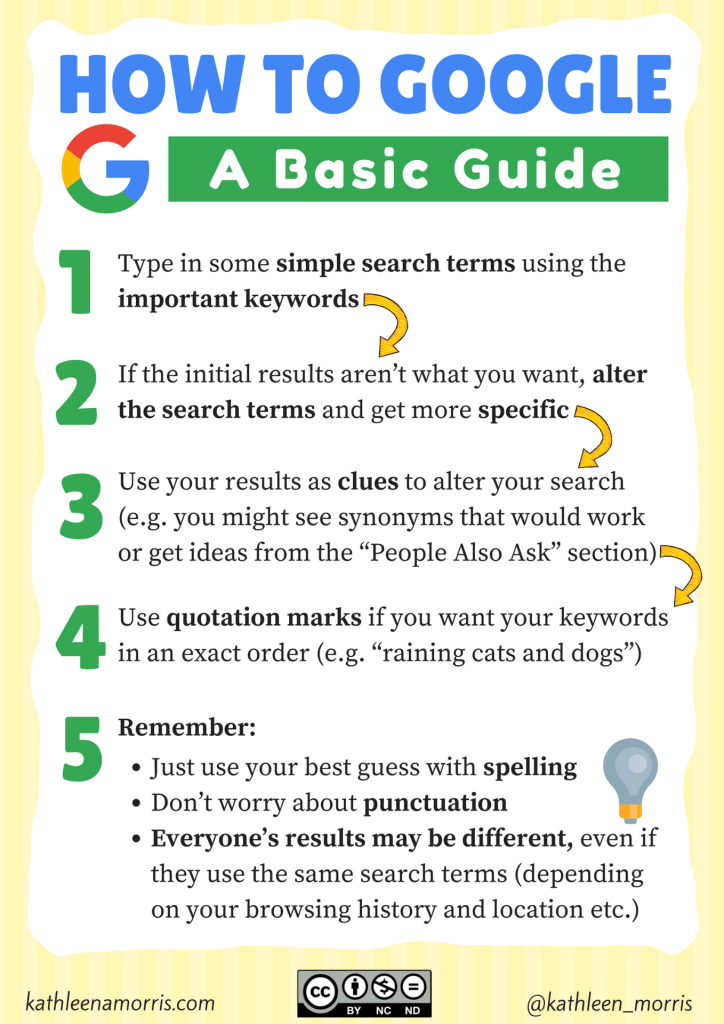

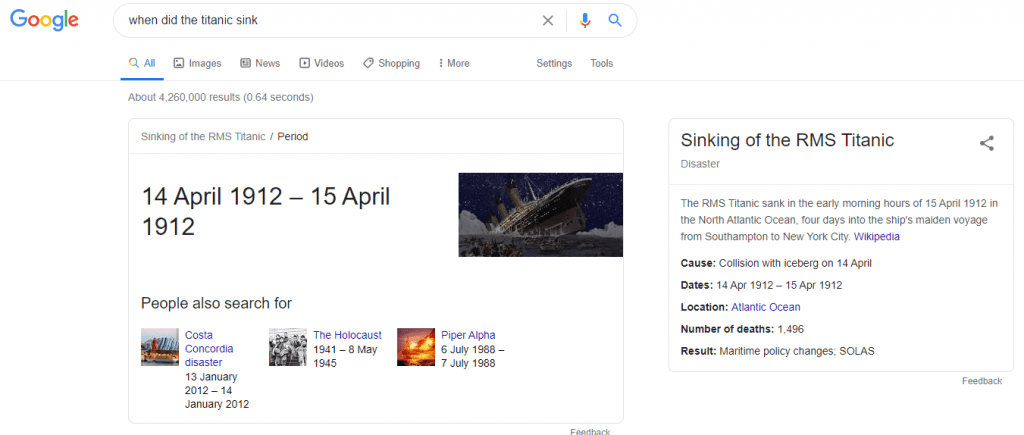
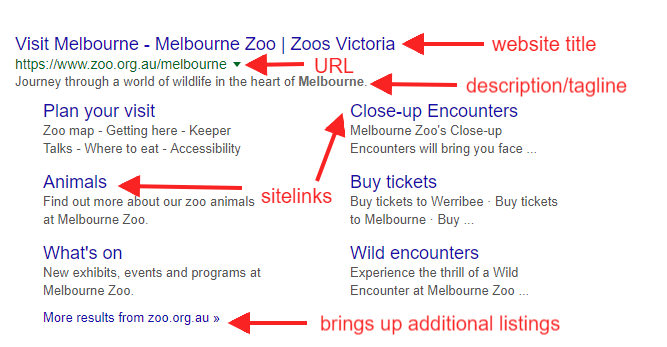


Kathleen, I like your point about opening up sites in new tabs. You might be interested in Mike Caulfield’s ‘four moves’.
What a fabulous resource, Aaron. Thanks so much for sharing. This is definitely one that others should check out too. Even if teachers don’t use it with students (or are teaching young students), it could be a great source of learning for educators too.
This is great information and I found the safe search sites you provided a benefit for my children. I searched for other safe search sites and you may want to know about them. http://www.kids-search.com and http://www.safesearch.tips .
Hi Alice, great finds! Thanks so much for sharing. I like the simple interface. It’s probably a good thing there are ads at the top of the listing too. It’s an important skill for students to learn how to distinguish these. 🙂
Great website! Really useful info 🙂
I really appreciate this blog post! Teaching digital literacy can be a struggle. This topic is great for teachers, like me, who need guidance in effectively scaffolding for scholars who to use the internet to gain information.
So glad to hear it was helpful, Shasta! Good luck teaching digital literacy!
Why teachers stopped investing in themselves! Thanks a lot for the article, but this is the question I’m asking myself after all teachers referring to google as if it has everything you need ! Why it has to come from you and not the whole education system! Why it’s an option? As you said smaller children don’t need search engine in the first place! I totally agree, and I’m soo disappointed how schooling system is careless toward digital harms , the very least it’s waste of the time of my child and the most being exposed to all rubbish on the websites. I’m really disappointed that most teachers are not thinking taking care of their reputation when it comes to digital learning. Ok using you tube at school as material it’s ok , but why can’t you pay little extra to avoid adverts while teaching your children! Saving paper created mountains of electronic-toxic waste all over the world! What a degradation of education.
Thanks for sharing your thoughts, Shohida. I disagree that all schooling systems are careless towards ‘digital harms’, however, I do feel like more digital citizenship education is always important!
Hi Kathleen,
I love your How to Evaluate Websites Flow Chart! I was wondering if I could have permission to have it translated into Spanish. I would like to add it to a Digital Research Toolkit that I have created for students.
Thank you!
Kristen
Hi Kristen,
You’re welcome to translate it! Please just leave the original attribution to my site on there. 🙂 Thanks so much for asking. I really hope it’s useful to your students!
Kathleen
[…] matter how old your child is, there are many ways for them to do research into their question. For very young children, you’ll need to do the online research work. Take your time with […]
[…] digs deep into how teachers can guide students through responsible research practices on her blog (2019). She suggests a 5 step model for elementary students on how to do online […]
Writing lesson plans on the fly outside of my usual knowledge base (COVID taken down so many teachers!) and this info is precisely what I needed! Thanks!!!